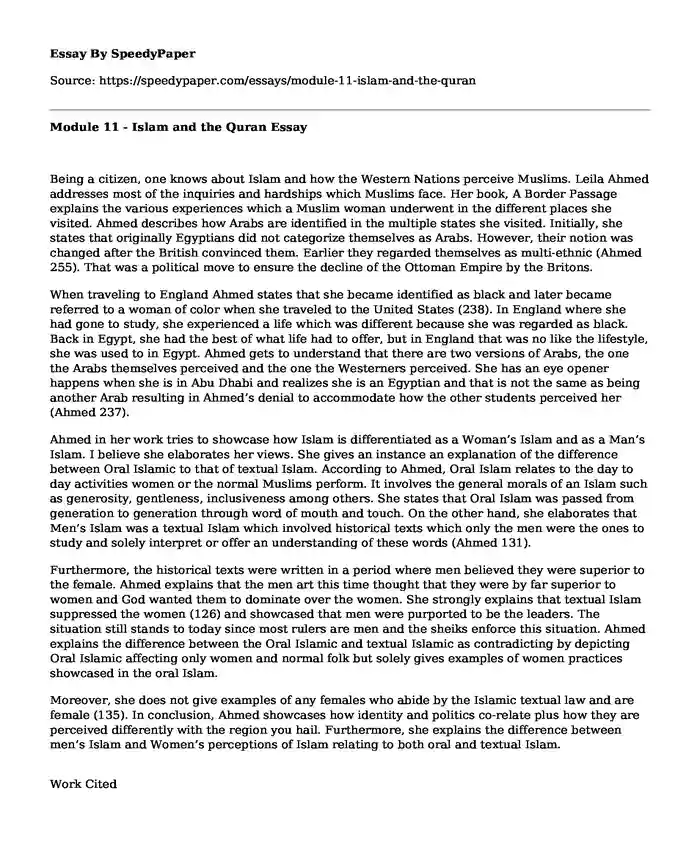
| Type of paper: | Essay |
| Categories: | Finance Analysis Technology |
| Pages: | 3 |
| Wordcount: | 558 words |
Being a citizen, one knows about Islam and how the Western Nations perceive Muslims. Leila Ahmed addresses most of the inquiries and hardships which Muslims face. Her book, A Border Passage explains the various experiences which a Muslim woman underwent in the different places she visited. Ahmed describes how Arabs are identified in the multiple states she visited. Initially, she states that originally Egyptians did not categorize themselves as Arabs. However, their notion was changed after the British convinced them. Earlier they regarded themselves as multi-ethnic (Ahmed 255). That was a political move to ensure the decline of the Ottoman Empire by the Britons.
When traveling to England Ahmed states that she became identified as black and later became referred to a woman of color when she traveled to the United States (238). In England where she had gone to study, she experienced a life which was different because she was regarded as black. Back in Egypt, she had the best of what life had to offer, but in England that was no like the lifestyle, she was used to in Egypt. Ahmed gets to understand that there are two versions of Arabs, the one the Arabs themselves perceived and the one the Westerners perceived. She has an eye opener happens when she is in Abu Dhabi and realizes she is an Egyptian and that is not the same as being another Arab resulting in Ahmed's denial to accommodate how the other students perceived her (Ahmed 237).
Ahmed in her work tries to showcase how Islam is differentiated as a Woman's Islam and as a Man's Islam. I believe she elaborates her views. She gives an instance an explanation of the difference between Oral Islamic to that of textual Islam. According to Ahmed, Oral Islam relates to the day to day activities women or the normal Muslims perform. It involves the general morals of an Islam such as generosity, gentleness, inclusiveness among others. She states that Oral Islam was passed from generation to generation through word of mouth and touch. On the other hand, she elaborates that Men's Islam was a textual Islam which involved historical texts which only the men were the ones to study and solely interpret or offer an understanding of these words (Ahmed 131).
Furthermore, the historical texts were written in a period where men believed they were superior to the female. Ahmed explains that the men art this time thought that they were by far superior to women and God wanted them to dominate over the women. She strongly explains that textual Islam suppressed the women (126) and showcased that men were purported to be the leaders. The situation still stands to today since most rulers are men and the sheiks enforce this situation. Ahmed explains the difference between the Oral Islamic and textual Islamic as contradicting by depicting Oral Islamic affecting only women and normal folk but solely gives examples of women practices showcased in the oral Islam.
Moreover, she does not give examples of any females who abide by the Islamic textual law and are female (135). In conclusion, Ahmed showcases how identity and politics co-relate plus how they are perceived differently with the region you hail. Furthermore, she explains the difference between men's Islam and Women's perceptions of Islam relating to both oral and textual Islam.
Work Cited
Ahmed, Leila. A border passage. Farrar, Straus and Giroux, 1999.
Cite this page
Module 11 - Islam and the Quran. (2022, Dec 06). Retrieved from https://speedypaper.net/essays/module-11-islam-and-the-quran
Request Removal
If you are the original author of this essay and no longer wish to have it published on the SpeedyPaper website, please click below to request its removal:
- Contradictory Assertions Essay Example
- New Regulations to Protect the Consumers - Financial Regulation Essay Sample
- Essay Sample on Increase in the Proportion of People with Medical Insurance
- Free Essay: Financial Management Undergraduate Personal Statement
- The Great Gatsby - Long and Short Answers, Literary Essay Example
- Essay Sample Describing the Effect of Vegetarian Diet on Weight Reduction
- Essay Sample on Personal Relationship and Wellness
Popular categories




